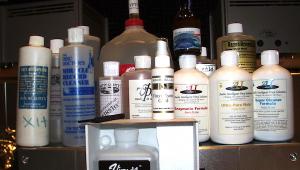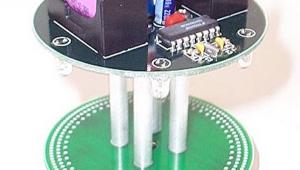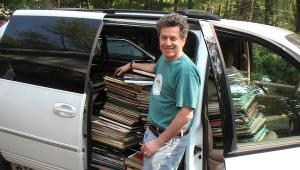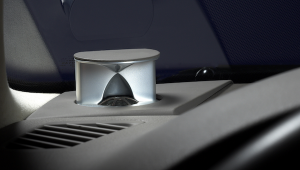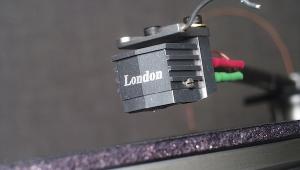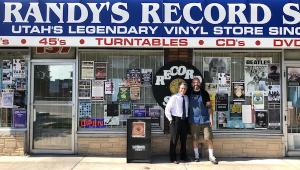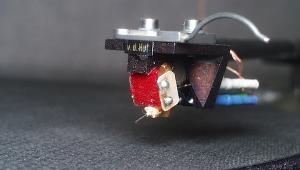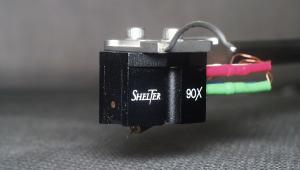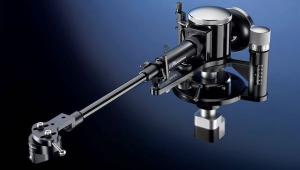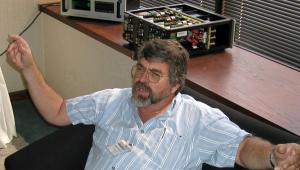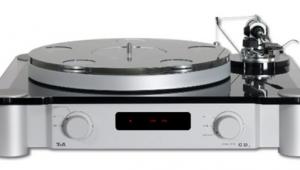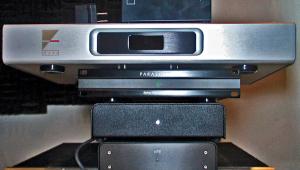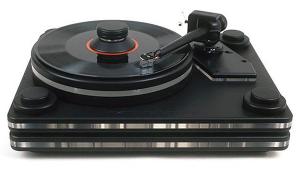Analog Corner #43

(Originally published in Stereophile, February 12th, 1999)
Every so often, when I get down (and I don't mean as in "get funky''), I wonder whether I'll run out of analog things to write about. After all, we're only a year from 2000, and this needle-in-the-groove invention is already more than 100 years old. What's left to say?
Or so I think when I get blue. But it doesn't last long, not with so many inspired correspondents writing and so many manufacturers creating new products—even though, as we all know, vinyl is dead.
And then there are the bizarre incidents. Like this morning—I had to take our brand-new car (300 miles) to the body shop for repairs. I can't tell you what happened because I'll get in trouble with my wife. (Oops, too late. I just did tell you.) Anyway, I'm talking with the guy who owns the body shop, and somehow we get on the subject of records.
"Hey, there's a wrecked Jetta back there with a trunkful of LPs. The car's being hauled off to the salvage yard later today. Wanna take a look?"
I do. Most of the albums are wet, stuck together, moldy, and of late-'70s/early-'80s vintage—Flock of Seagulls, Billy Joel, Robert Hazard, etc.—stuff that would have gotten moldy and stuck together even if it hadn't gotten wet. But all of a sudden I come upon an original purple-and-brown-label Atco pressing of Cream's Disraeli Gears! And then a clean Mobile Fidelity pressing of Al Stewart's The Year of the Cat! And, finally, sealed copies of John Mellencamp's Uh-Huh and Waylon Jennings' It's Only Rock and Roll. I also got Tina Turner's Private Dancer and Roxy Music—The Atlantic Years. "Car accidents: a good thing!''—another Stewart.
Another bizarre incident: Last night I went to WFMU's record fair. (WFMU is a great, independent freeform radio station in the NY/NJ Metropolitan area. 91.1 FM, available online using RealPlayer at www.wfmu.org.) While thumbing through some LPs I came upon a sealed copy of I Can Take Joke, a comedy album I'd put out in the mid-'70s! I said to the guy, "Hey! That's me! I put this out over 20 years ago!" He peeled back some of the shrink-wrap and asked me to autograph it, which of course I did. Yet another unnecessary boost to my massive ego.
Speaking of the death of vinyl, the record fair was on a Saturday and Sunday, $5 admission. But the truly desperate could pay $20 for to spend two and a half hours of Friday night in a basement full of vinyl. Naturally I went, and the place was packed! What's more, the hair was black, brown, and red—hardly a touch of gray in the joint. This was not a record convention of "alta cockers."
So I have to laugh when I read silly, mean stuff like the following, a quote from CEMA prez Gary Shapiro in a magazine supplement called The Dawn of Digital Television: "Ten to 15 years from now, our children will look back on current television the way we look at turntables—as historical anomalies." In fact, I called Shapiro on his statement at the HDTV conference for which the supplement was created. I told him that a) turntables were not going away, and would be around in "10 to 15 years''; that b) young people are buying them now and will continue to do so; and that c) on the very day of the conference, more turntables would be manufactured, purchased, and certainly played than HDTVs.
What's more, I told him, I was confident that that would still be the case in five years. I'm not so sure I'd be wrong in predicting that for 10 or 15 years from now. And anyway, I told him, why pick on turntables? A more appropriate whipping boy would be VHS video tape, a truly crappy format that hopefully will be an "anomaly" in 10 to 15 years, as we get digital television and video storage on hard drives. Anyway, being able to talk back directly (politely and respectfully) and in person to the perpetrators of incorrect anti-analog sentiment is one of the great privileges and pleasures of this job.
Another is getting surprise packages in the mail. A few weeks ago one arrived from Denon, sent to me by Nobuhisa Tokutake, vice president of Denon Active Media. Inside was a vinyl LP, a copy of a test record first issued two decades ago, and which Denon is again making available to consumers. Originally called the Denon Audio Technical Record (XG-7001), it is sourced from the original metal "mother," which Denon kept in its vaults along with the metal parts of all of its vinyl music releases. As the new millennium approaches, Denon plans to reissue some of the titles on vinyl.
Hear that, Shapiro? As the 20th century draws to a close, Denon--one of the innovators in PCM technology—is releasing software for an "anomaly." Denon's record division was established back in 1910.
The test record, now called the AD-1, was released by the Japan Audio Society last October at the Audio Expo in Tokyo. Ironically, it was pressed on 180gm vinyl at RTI in Camarillo, California—like JVC, Denon made the mistake of junking its presses. At least EMI-Toshiba is still up and running in Japan, pressing some fine-sounding discs, including a recent Blue Note series and the Beatles' back catalog, plus the three Beatles Anthology sets, which sound much better than either the American or British issues.
Mr. Tokutake, who engineered Denon's turntable line, told me that in preparation for the release of the test disc, the engineers went back to the vaults and pulled lacquers, metal masters, mothers, and stampers. Some metal parts had been rendered unusable by air pollution, but enough survived unscathed for test pressings to be made. The 180gm RTI pressings proved to be the most accurate.
The record comes with a full-sized illustrated glossy booklet in English and Japanese, and while the record's optimum use can be realized only with a B&K level recorder, charts plotting frequency vs time, for example, are included. These can be used with a stop watch and a conventional SPL or voltage meter to measure approximate frequency response and crosstalk.
The bands on side one include left- and right-channel sweep frequencies for measuring cartridge frequency response, crosstalk, and harmonic distortion; a series of eight sinewaves for the left and right channels which can be used to calculate a cartridge's mechanical impedance (you'll need an oscilloscope to determine proper stylus pressure); a low-frequency sweep that can help you determine your arm/cartridge's low-frequency resonant frequency; and a wow-and-flutter measurement track (you'll need test gear).
Side two's bands include 1/3-octave pink noise at 40 different frequencies, a "flat zone" located at a precise point on the record for setting antiskating (I'm not convinced this is the best way to set antiskating), left and right reference levels, and nonmodulated grooves for measuring a system's signal/noise ratio.
Clearly, many of the bands on this carefully created test tool are of little or no use to the average, nontechnically-oriented vinyl enthusiast, and the booklet's Japan-speak translations do not help. However, one band makes owning the $49.95 disc worthwhile. In order to optimize azimuth (the cantilever's perpendicularity to the grooves), it is necessary to measure, minimize, and equalize crosstalk between channels. This is not the same as aligning the cartridge to equalize electrical output!
I've made this point many times, but I still see the out-of-phase mono-signal methodology being recommended as the way to set azimuth. It ain't! The only way to set it correctly is to get a test record with left-only/right-only modulations and measure output and crosstalk. Azimuth is optimized when you've minimized and equalized crosstalk. Then and only then will you have maximized channel separation, and thus soundstage width, depth, and focus. I've written about this at length before, and will do so again.
The problem is, there hasn't been a well-pressed disc available that gives you the proper left-only/right-only tones. Most of the commercial test discs are so poorly produced that they contain gross fluctuations in output that make measuring the signal extremely difficult. This Denon disc is superbly produced—the output remains virtually fixed for the entire length of the band.
Mr. Tokutake asked me for some feedback on AD-1; I hope to spend some time with him so he can suggest to me how nontechnical vinyl enthusiasts can use the disc for other playback-optimization purposes without test gear. The supplied booklet is simply too complex, and assumes too much knowledge on the part of the end user, to be useful to most of us.
He also sent me a copy of a really basic but informative booklet on analog playback that Denon used to supply to its sales representatives—but that was 15 years ago, before the turntable became an "anomaly." It's not currently available.
Big Hole
This is Analog Corner No.45, so it needed a big hole in the middle.
I started a joke
A while back in this column I reacted to a news item about a new CD-manufacturing process that included a "guide" groove between pits to help the laser servo track the spiral more efficiently. Eventually, I speculated jokingly, a tiny stylus would be introduced for even better tracking.
Well, guess what? A number of readers have sent me an article from the May 1998 issue of Popular Science about a new penny-sized CD system invented by Stephen Chou, an electrical engineering professor at the University of Minnesota, which has 800 times the capacity of a CD and 100 times that of a DVD. The tiny pits of data, ten billionths of a meter wide and 49 billionths of a meter apart, are stored in grooves...which are read by a tiny, vibrating silicon needle.
Not so funny but really useful
At the September '98 Heathrow Hi-Fi Show, sponsored by Hi-Fi News & Record Review, which I reported on in December (Vol.21 No.12), I was handed a new strain-gauge stylus-pressure gauge manufactured by The Cartridge Man. This neat little digital-readout device sells for around $295—less than a third of the cost of the Winds gauge, currently the "industry standard." The Cartridge Man offers 0.02gm resolution and ±0.02gm accuracy over a range of 0.2 to 4gm. It operates via a long-lived rechargeable battery (a charger is supplied) good for 30 minutes of operation per charge.
One thing I really like about the new gauge is that, unlike the Winds' weighing beam—which protrudes from the side, making it vulnerable to accidental and potentially damaging blows—the Cartridge Man's beam is well protected by a surrounding platform. Use is straightforward and explained in almost maddening detail in the 41-page (!) manual. Upon turn-on, the unit automatically "nulls" itself to 0gm, compensating for electronic and temperature drifts. Once the unit is powered up, you can monitor the battery's status by holding down the power button for three seconds. The LED display will read out the voltage.
I used a 2gm brass weight lab-certified as accurate to three zeros, supplied to me by Wally Malewicz for use with his $80 beam gauge (which he's promised to send me but for some reason hasn't yet). The Cartridge Man gauge measured the weight as 1.98gm, which for me is more than adequate. Once you get VTF to this blade of grass in the ballpark, you're going to want to set it by ear anyway. The Cartridge Man gauge is guaranteed to perform to spec for one year, and the rechargeable battery should last approximately five years. As there seems to be no American distributor at this time, if you're interested in buying the unit, contact The Cartridge Man directly at 88 Southbridge Road, Croydon, Surrey CRO 1AF, England, UK.
Expert Stylus Company
Many columns ago, I recommended the Expert Stylus Company as a source for stylus replacement and cartridge rebuilding. A number of readers who'd sent the company their Koetsus (back when the line was not being imported domestically) have reported back to me that they were very happy with the company's service, prices, and the final sonic result. A few thought Expert's rebuild sounded better than what had come from Koetsu in the first place.
Expert is run by Wyndham D. Hodgson, a trained horologist (a maker of timepieces, or watchmaker), who ran a lapidary business (cutting and polishing gemstones) that also supplied styli to the hi-fi industry. Hodgson eventually took over Expert Pickups, which manufactured the popular (in the UK) Expert cartridge. When that was discontinued, Hodgson changed the name to Expert Stylus Company.
Today, Expert, in business for more than 27 years, manufactures over 100 different diamond and sapphire stylus shapes covering every period in the history of analog playback. The majority of these are from the 78rpm era (the company even supplies styli for Edison cylinder playback), before there were established standards.
With the introduction of the microgroove LP after World War II, a 0.001" conical stylus became the standard, followed by 0.0005" for stereo. The industry compromised at 0.0007" for both mono and stereo playback. Introduced later, of course, were elliptical, line contact, and other exotic shapes that more closely resembled the chisel-like cutter-head stylus. Expert supplies those as well.
While most readers of this column would be more interested in moving-coil stylus and/or cantilever and stylus replacement, Expert also replaces worn styli on moving-magnet cartridges at very reasonable prices. Most replacement diamonds, using customer-supplied assemblies, cost significantly under $100.
More exotic moving-coil cartridges may require more extensive rebuilding, including damping and suspension work; readers are urged to write or phone for quotes. Should you have Expert do the work, or should you send it to the original manufacturer? I'm inclined to think that if you snap a cantilever on a model currently in production, you're better off sending it to the manufacturer so that your cartridge comes back with the original parts—including coils, former, and cantilever. But I'd call Expert anyway; see what they offer and how much they charge.
Expert sent me a sample of a green, Silly Putty–like substance attached to a piece of plastic, which it recommends in place of chemical-based stylus-cleaning fluids. The majority of cartridges with sapphire, boron, or diamond cantilevers use a chemical bonding material to hold the stylus in place. Expert claims that the use of such fluids can soften the bond and result in the diamond falling out. The green substance is "offered up" to the diamond, which should be allowed to penetrate the surface.
Expert Stylus Company, P.O. Box 3, Ashtead, Surrey KT21 2QD, England, UK. Tel: (44) 01372-276604. Fax: (44) 01372-276147.
Late-breaking developments
VPI has introduced a new universal AC-synchronous motor drive (also usable, of course, with its own line of turntables), a sample of which arrived shortly before deadline. I'll report on it next time. Price is $1200. Also, American Hybrid Technology's Dan Fanny called to remind me that he designed the Walker phono drive I wrote about recently ("Analog Corner," November 1998). I apologize for not giving him credit.
A second bit of news: I just received a new Ringmat Support System, imported here by Music Hall. The $250 kit contains a highly acclaimed Ringmat 330 Mk.II XLR record mat, an LP Statmat (which "evens out" the electrostatic charges that build up as the platter and spindle rotate), a Ringcap (a lightweight device that sits atop a record on the label area), and a series of spacers for adjusting SRA (stylus rake angle) for arms that do not allow VTA adjustments. It's a complex kit, and I haven't had a chance to play with it yet. When I do, I'll give you a full report on what it is, what it does, and what effect it has on the sound.
I have also recently received the Absolute Polarity Phase Control (APPC) from the Lewis Electronics Company. This $600 component allows you to play with "absolute phase" via a remote-controllable device. Obviously, it requires a break in the direct signal path from the tonearm leads to the phono preamp. Whether the benefits to be derived from being able to reverse absolute phase outweigh the deleterious effects of putting a series of (short) cables and connections in the low-level signal path remains to be heard.
Finally, the cool-looking, pipe-bomb–like Kuzma Stabi S tonearm just arrived for review, as did a new $995 Thorens turntable. Oh, and Grado just sent its Statement moving-iron phono cartridge, the company's lowest-output (0.75mV), highest-cost ($2600) cartridge ever. Oh! And the new $1275 Rega Planar 25 turntable just arrived directly from the factory—I'm gonna get on it right away!
So here we are, less than a year away from 2000, and I'm overwhelmed with new analog playback gear and accessories. The turntable as an "anomaly" in the 21st century? Not.
